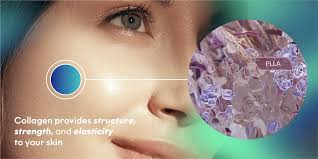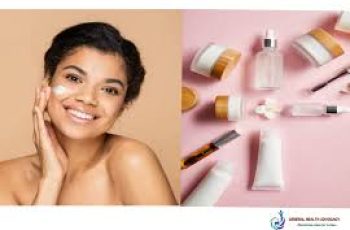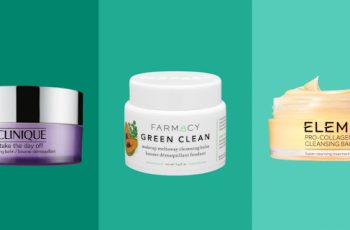
How To Restore Collagen in the Face
Discover the science of youthful skin as we delve into the intricate world of collagen. This powerhouse skin protein constitutes 75% of your skin’s dry weight. Learn how to rebuild and restore collagen in your skin giving it natural resilience, strength, and a smooth, youthful appearance.
From essential enzymes to the critical role of Vitamin C, we illuminate the biochemical pathways that stimulate collagen production. Uncover evidence-based strategies to increase collagen levels in your skin, not just through skincare products but also with food and supplements. Don’t miss this comprehensive guide for an informed approach to anti-aging skincare that focuses on stimulating collagen production in the skin.
How To Restore Collagen in Skin
The fibroblast skin cells in the dermal layer of your skin make collagen and secrete it into the space between skin cells known as the extracellular matrix (ECM) where it forms a structural scaffolding. The collagen in your skin gives skin strength and thickness. Loss of collagen leads to thin, wrinkled, fragile skin. Methodologies and treatments such as skin care products, supplements, and diet can help increase collagen levels in the skin.
But- guess what- taking collagen powders and supplements is not the best way to increase skin collagen. In fact, these collagen supplements are not very effective.
The best way to rebuild and restore collagen in your skin is to give your skin the building blocks, enzymes, and communication signals it needs to make collagen naturally.
Proline in a solution of vitamin C becomes hydroxyproline
How Skin Makes Collagen
Collagen formation is a fascinating biochemical process that starts within specialized cells known as fibroblasts. Here, collagen begins its life as a precursor molecule called procollagen. The real magic happens when specific amino acids in this procollagen chain undergo transformations, thanks to enzymes. Proline, for instance, is converted into hydroxyproline by the enzyme prolyl hydroxylase. For this transformation to take place, you need some essential players: iron (Fe++), Vitamin C (ascorbic acid), and α-ketoglutarate.
Similarly, lysine residues get an upgrade too; they turn into hydroxylysine under the action of another enzyme named lysyl hydroxylase. And guess what? This reaction also calls for the same trio of vital components—iron, Vitamin C, and α-ketoglutarate. So, understanding these intricate biochemical steps can give you a newfound appreciation for the role of diet and nutrition in maintaining youthful, resilient skin.
vitamin c
The Crucial Role of Vitamin C to Rebuild Collagen
Vitamin C (ascorbic acid) plays an indispensable role in the production of collagen, specifically in the conversion of proline into hydroxyproline. This transformation is facilitated by the enzyme prolyl hydroxylase, which requires Vitamin C to function. Without this vital vitamin, the biochemical pathway stalls, hydroxyproline is not produced, and the synthesis of collagen becomes compromised.
This is why Vitamin C plays such a critical role in skin rejuvenation. If you do not have enough Vitamin C, it does not matter what else you do to rejuvenate your skin- collagen cannot be made without it!
This means that stem cells, growth factors, exosomes, peptides, and other antiaging ingredients are worthless without the presence of Vitamin C in the skin.
Intriguingly, studies have shown that when Vitamin C is added to fibroblast cell cultures, there’s a marked increase in collagen production. (3) This underscores not only the essential role Vitamin C plays in collagen synthesis but also its potential effectiveness at boosting collagen production. Therefore, Vitamin C serums, foods high in Vitamin C, and supplements containing sources of Vitamin C or Vitamin C itself are important components of a skin rejuvenation strategy.
[[T04]]
Best collagen creams
Best Collagen Creams
Creams with collagen in them do not penetrate into the skin and cannot increase levels of collagen in your skin so they do not work. However, there are other creams and serums that can increase skin collagen. See a list of these collagen rebuilding products below.
You must use a Vitamin C serum or take Vitamin C supplements or have a lot of vitamin C in your diet for these collagen increasing creams and serums to work.
Which types of skin care products work better than creams with collagen in them to stimulate collagen production in the skin?
Exosomes
Exosomes are small naturally occurring spheres that cells release to communicate with each other. These can be extracted from yeast, plants, animals and humans and used in skin care products. Only human derived exosomes are helpful to increase skin collagen. (Plants do not have collagen so their exosomes do not have the correct signal to stimulate collagen production).
The exosomes with the most evidence based studies are platelet-derived exosomes. Scientists have discovered that platelet-released exosomes contain a variety of factors that can promote skin rejuvenation and wound healing. These act as signaling molecules, communicating with cells to stimulate collagen production, cell regeneration, and blood vessel growth.
Initial studies suggest applying platelet-derived exosomes topically may have anti-aging and restorative benefits. The growth factors in platelet exosomes, like PDGF and TGF-β, appear to activate fibroblasts and stem cells in the skin, ramping up production of new collagen.
The most studied of these collagen stimulating exosomes serums are the Plated Skin Science Serums that contain human platelet derived exosomes.
Growth Factors
Because of its central role, topical TGF-β is the best growth factor to increase collagen regeneration in aging skin. Other growth factors like platelet-derived growth factor (PDGF), epidermal growth factor (EGF), and fibroblast growth factor (FGF) also regulate collagen synthesis, but TGF-β is the best and safest growth factor to rebuild collagen.
Hydroxyacids
Hydroxyacids, especially AHAs like glycolic acid, have good evidence based research to support their use in regenerating skin collagen. These can be found in many different types of collagen boosting products such as cleansers, toners and peels.
Which to choose depends upon your Baumann Skin Type and what other skin car products are in your skin care routine. The low pH of hydroxyacids can be harnessed to help your Vitamin C serums penetrate better.
Hydroxyacid cleansers are good to use before Vitamin C serums.
[[C04]]
Hydroxyacid creams can be used after Vitamin C in the skin care routine. Begin with a lower strength hydroxyacid cream.
[[T07]]
Then once you get used to it you can increase to a medium strength.
[[T08]]
To rebuild collagen in the body such as the arms, legs or stomach, use a high strength hydroxyacid cream.
[[T06]]
glycolic acid
Peptides
Many peptides claim to increase collagen. However, there are too many peptides to list here. See this comprehensive peptide blog to learn more.
These are the best antiaging serums and crems with peptides to increase skin collagen:
Retinoids
Retinoids like retinol are the best way to rebuild collagen in the face. Your entire skin care routine should be designed to help the retinoid in your routine work well without causing side effects. Hint- your cleansers and moisturizers that you use with retinoids really matter.
There is a lot of science to support the use of retinoids to increase skin collagen.
These are good retinols for beginners. Make sure you follow the directions at this link and use them properly.
[[T11]]
retinoids for collagen
Diet, Collagen Powders, and Supplements
Collagen is a protein that’s naturally abundant in animal-based products like meat, poultry, and fish. For omnivores, these sources make it relatively straightforward to incorporate collagen into their diet. However, vegetarians and vegans might find it more challenging to obtain this important protein. To navigate this, they can opt for collagen powders and supplements specifically designed to be plant-based. Alternatively, a diet rich in Vitamin C and specific amino acids can provide the necessary building blocks for collagen synthesis. The key amino acids required for collagen production are:
Glycine – Found in plant-based sources like cauliflower, lentils, kale, soybeans, spinach, and pumpkin seeds.
Proline – Abundant in asparagus, beans mushrooms, nuts, cabbage, and seeds.
Hydroxyproline – Less commonly found in plant-based foods, but can be supplemented through plant-based collagen powders.
Arginine – Available in lentils, pumpkin seeds, soybeans, peanuts, chickpeas, and whole grains.
By ensuring an intake of these amino acids and Vitamin C, vegetarians and vegans can promote their body’s ability to produce collagen.
Collagen supplements and powders are not necessary if you have a heathy diet of the above foods or if you eat meat or bone broth. Bone broth is a rich source of collagen in the diet.
This is a vegan supplement to support collagen in skin.
₫
₫
See Product
Wounding Skin Increases Collagen
The scarring process also involves collagen, so even though you want more collagen, too much results in scars and keloids. There are many treatments that wound the skin to improve skin texture but these can all backfire and cause scarring if done excessively, incorrectly, or if an infection occurs. I recommend you see a professional medical provider such as a dermatologist to have these collagen stimulating procedures done.
Always use Vitamin C serums, supplements and eat foods high in Vitamin C when undergoing one of these rejuvenation procedures.
[[T04]]
Exosomes contain growth factors that can help speed healing and help restore collagen.
Growth Factors and Wounds
When you get an injury, an army of cells and signals team up to help patch you up. Some MVPs (most valuable players) that rush to the scene are growth factors like PDGF, TGF-β, FGF, EGF, and VEGF. These growth factors act like team captains, directing the healing process by telling cells to divide, migrate, and build new blood vessels and tissue in the wound. Other key players are cytokines, including TNF-α, IL-1, and IL-6, which regulate inflammation and call for backup cells. Interleukins like IL-2 and IL-4 also join the squad by activating immune cells to proliferate and do their jobs. It’s amazing how the body can orchestrate this complex healing operation through the signals of various growth factors, cytokines, and interleukins. With the help of these all-star injury responders working together, damaged tissue can recover and get back in the game!
Lasers
Lasers like CO2 or Erbium can rejuvenate aged or damaged skin through precise tissue targeting. These lasers create small wounds that stimulate growth factors such as TGF-β. TGF-β signals fibroblasts to migrate to the treatment area, where they synthesize new collagen. Multiple stimulating laser sessions promote collagen production and skin renewal, effectively turning back the clock on skin aging. However, the doctor administering the laser must remain vigilant. Excessively deep laser wounds can overwhelm the skin’s capacity for proper healing. This may result in scarring from unregulated collagen deposition or hypopigmentation from melanocyte damage. The key is to induce measured micro-wounding just sufficient to activate tissue repair and collagen synthesis pathways. When used judiciously, fractionated resurfacing lasers can prompting skin rejuvenation through new collagen production, without inducing permanent scarring or discoloration.
What are growth factors
Microneedling
Microneedling causes skin wounding and increases and restores collagen in skin. How effective this is depends upon:
the size of the needles
the diameter of the needles
the skill of the medical provider
what is used on the skin 2 weeks prior
what is used n the skin immediately after
what is used on the skin 2 weeks after
Injections to Increase Collagen
Various substances can be injected into skin to increase collagen production. Find a dermatologist or well trained reputable medical provider to do these. Beware of anyone doing this outside of a medical setting!
Polylactic acid (Sculptra) Injections
Sculptra is a injectable cosmetic treatment that uses poly-lactic acid to stimulate collagen production. It serves as a bio-stimulator, prompting fibroblast cells to ramp up their collagen-making activities. The result is a gradual restoration of volume and a smoothing of skin texture in the treated areas. Sculptra offers a unique approach to anti-aging by directly engaging the body’s own collagen production mechanisms to enhance both volume and texture.
Sculptra requires 3-6 treatments spaced one month apart.
Sculptra works best if you pretreat your skin and use Alastin Regenerating Skin Nectar between treatments. This helps “clear out” old broken collagen and cell debris making room for new collagen. You should also combine with a Vitamin C serum to help support collagen production.
[[T04]]
Platelet Rich Plasma (PRP)
Platelet-rich plasma (PRP) injections offer another innovative approach to stimulating collagen production for skin rejuvenation. In this procedure, a small amount of the patient’s own blood is drawn and then spun in a centrifuge. This process separates the blood components and concentrates the platelets in the plasma. The enriched plasma, now rich in platelet extracts, is then injected back into the skin. Platelets are known for their role in wound healing and contain growth factors that can activate fibroblasts to produce more collagen. By introducing this platelet-rich serum into the skin, the procedure leverages the body’s natural healing mechanisms to promote collagen synthesis. The result is an improvement in skin texture, offering a unique and organic path to anti-aging.
Topical platelet-derived extracts similar to PRP are found in the skin care brand Plated Skin Science.
I interview the transplant cardiologist from Mayo Clinic Dr. Atta Behar who developed the PRP-like topical antiaging serum called Plated.
This video explains the science behind platelet derived exosomes.
Collagen changes in Aging Skin
The collagen network in our skin goes through changes as we age. Type I collagen makes up about 80% of the total collagen in young, healthy skin, while type III collagen comprises around 15%. These collagen molecules are neatly arranged in parallel bundles, creating an orderly scaffolding that supports the epidermis.
Overall, total collagen content decreases about 1% each year after age 20. (1,29)
Around age 40, the ratio of type III to type I collagen increases, meaning there’s less type I collagen as we get older. This can happen sooner in sun exposed skin. Research shows type I collagen levels decline by 59% in sun-damaged skin, correlating with the extent of photodamage. (27,28) This is why some skin types need to start antiaging skin care before the age of 30!.
During the hormonal changes of menopausal , there are significant changes in skin composition, most notably a marked acceleration in collagen loss and a consequent thinning of the skin. Scientific data indicate that Types I and III collagen undergo a decline of up to 30% within the first five years following a drop in estrogen levels. (1,26)
While type I collagen dominates the dermis, scientific studies reveal the other minor collagen types also change with aging.
Understanding your risk of collagen loss will help you know when it is time to begin antiaging ingredients in your skin care routine.
Take the Quiz
Summary and Bottom Line:
The amount of Type 1 collagen directly correlates to how old your skin looks. You cannot make new collagen without Vitamin C. You can use various skin care products such as exosomes and growth factors to increase collagen production, but these work best when enough Vitamin C is present. You should add Vitamin C to your diet, drinks, supplements and skin care products.
Topical Vitamin C products are unstable, react with other products and do not penetrate well, so your entire skin care routine and skincare product step order really matters! The perfect skin care routine to increase collagen in your skin depends upon your Baumann Skin Type.


